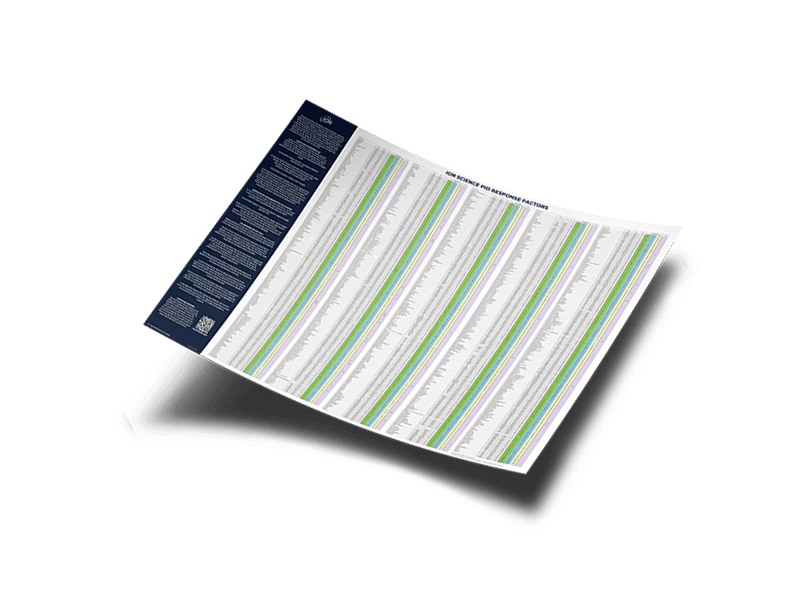

Home » ION Science PID Response Factor Chart

This downloadable response factor chart serves as a comprehensive reference, providing you with essential gas information including gas names, formulas, CAS numbers, ionization energies, and recommended lamp variants.
It addresses the needs of researchers and industry professionals by offering swift access to information on specific gases that PID can detect. Plus, the inclusion of detailed chemical formulas proves advantageous for individuals engaged in a spectrum of chemical processes.
The chart includes RFs for important chemicals, listed by their common names, but CAS numbers are recommended for precise identification. RFs are guideline figures, subject to variation based on PID design and operating conditions. ION Science advises calibrating the instrument to the target gas at the desired measurement concentration for accuracy.
Users should exercise caution in measuring PID responses at high or low concentrations, considering non-linearity, sensor clear-down time, and potential contamination of the PID window. Frequent calibration or bump tests are recommended, especially for less common volatiles. RFs labeled as ‘ZR’ indicate zero response, and ‘NA’ signifies an unavailable or insignificant value at toxic concentrations.
The RFs of many chemicals have been measured at ION Science typically with 10 and 50 ppm of the target volatile, using ten PIDs containing lamps of different photon energy and intensity and of different sensor designs. Generally, 50 ppm responses have been used. These RFs are indicated in bold in the chart.
ION Science Inc.
4153 Bluebonnet Dr.
Stafford, Texas 77477
Tel: +1 (877) 864-7710
info@ionscienceusa.com

© 2025 Ion Science USA. Ion Science is registered trademark on Ion Science Ltd
Fill out the form below and our team will get back to you shortly.
Diffusion Fixed Gas Detection Device
A diffusion gas detection device works, as the name suggests, on the diffusion principle. The sensor is exposed to the ambient air and will measure the gas by means of the diffusion principle. Diffusion means proportional spread of molecules over the available space (from high concentration to low concentration). This also means that a diffusion gas detection device is only able to measure the concentration of gases at the location where the device is located. Since there is no forced flow of the gas to be measured, this device is not suitable for taking measurements remotely, but they do accurately identify what’s present in a given location.
Pumped Fixed Gas Detection Device
Pumped instruments are equipped with a built-in sampling pump. This means that the device is constantly drawing in gases. A sampling hose may be connected to extend the reach. This means that you can take a measurement from a safe distance so you have an idea of which gases will be present in which concentration before you are exposed to this environment. This allows you to make an appropriate risk analysis and make the right strategy and PPE choices based on the measurement results. By positioning the measuring hose correctly, you can also make a correct measurement at different heights to chart all risks.
Hub Spot Submit CV form
Register your instrument placeholder for Hub Spot Form
Request a quote — HubSpot form
Please scroll to compare more OEM Sensors
Please scroll to compare all OEM Gas Sensors, tick to hide sensors to compare the most suitable variants.
| Hide | ||||||||
|---|---|---|---|---|---|---|---|---|
| Comparative specifications | 
| 
| 
| 
| 
| 
| 
| 
|
| Sensor Variant | MiniPID 2 PPM WR VOC Sensor | MiniPID 2 PPM VOC Sensor | MiniPID 2 PPB WR VOC Sensor | MiniPID 2 PPB VOC Sensor | MiniPID 2 HS VOC Sensor | MiniPID 2 10.0 eV VOC Sensor | MiniPID 2 11.7 eV VOC Sensor | MiniPID 2 PPB XF Sensor |
| Electrode Stack Colour | Blue | Blue | White | White | Red | White + Gold Spot | White | White + Filter |
| Minimum Detection Limit | 500 ppb | 100 ppb | 20 ppb | 1 ppb | 0.5 ppb | 5 ppb | 100 ppb | 1 ppb |
| Range | 0 to >10,000 ppm | 0 to 4000 ppm | 0 to >200 ppm | 0 to >40 ppm | 0 to >3 ppm | 0 to >100 ppm | 0 to >100 ppm | >40 ppm |
| Response Time T90 (s) | <3 | <3 | <8 | <8 | <12 | <8 | <8 | <12s |
| Sensitivity | >0.4 mV/ppm @ 100ppm | >0.65 mV/ppm @ 100 ppm | >5 mV/ppm | >30 mV/ppm | >600 mV/ppm | >15 mV/ppm | >1 mV/ppm | >30 mV/ppm |
| Lamp Energy | 10.6 eV | 10.6 eV | 10.6 eV | 10.6 eV | 10.6 eV | 10.0 eV | 11.7 eV | 10.6eV |
| Product Details | Product Details | Product Details | Product Details | Product Details | Product Details | Product Details | Product Details |